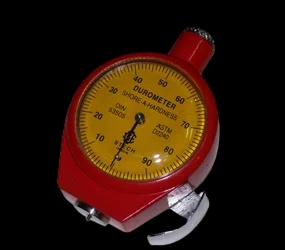Have you ever wondered about the hardness of everyday items? From rubber bands to shoe soles, the Shore A durometer is the key to understanding the tactile experience. In this article, we'll unravel the mysteries of Shore A hardness, exploring its importance and shedding light on the factors that make it a crucial consideration in various industries. So, buckle up and get ready for a journey into the fascinating world of material hardness!
- Understanding Shore A Hardness
Shore A hardness is a measure of the resistance of a material to indentation or penetration by a durometer. In simple terms, it tells us how soft or hard a material feels. Imagine pressing your thumb into a rubber ball—that sensation is influenced by Shore A hardness.
- How Shore A Durometer Works
Ever wondered how a small handheld device can measure hardness? The Shore A durometer works by pressing a specified indenter into the material and then measuring the depth of penetration. The greater the resistance, the higher the Shore A hardness.
- Importance in Material Selection
Choosing the right material for a specific application is crucial. Shore A hardness helps manufacturers select materials that provide the desired level of flexibility or rigidity, ensuring optimal performance and user satisfaction.
- Shore A Hardness Scale Explained
The Shore A hardness scale ranges from 0 to 100, with higher values indicating greater hardness. Soft materials like gel insoles might fall in the 20-30 range, while car tires, which need to be more durable, might rank higher, around 70-80.
- Applications Across Industries
Shore A hardness isn't limited to one industry. From automotive to healthcare, this measure plays a pivotal role. For example, in the medical field, it helps design comfortable yet supportive products like prosthetics or orthopedic insoles.
- Factors Affecting Shore A Hardness
What makes one material softer than another? Factors such as chemical composition, processing conditions, and even environmental factors contribute to the final Shore A hardness of a material. It's a delicate balance!
- Measuring Shore A Hardness: A Step-by-Step Guide
Curious how professionals measure Shore A hardness? We'll guide you through the process step by step, making it as simple as a walk on the beach.
- The Goldilocks Zone: Finding the Right Hardness
Just as Goldilocks sought the perfect porridge, finding the right Shore A hardness is about balance. Too soft, and the material may not endure; too hard, and it might lack the desired comfort. It's all about finding that sweet spot!
- Shore A vs. Shore D: Decoding the Hardness Dilemma
The world of hardness isn't one-size-fits-all. Dive into the differences between Shore A and Shore D hardness and discover when each is the perfect fit for your needs.
- Ensuring Durability: Impact on Product Lifespan
Hardness directly affects the lifespan of products. Discover how choosing the appropriate Shore A hardness can enhance the durability and longevity of everyday items.
- Challenges in Maintaining Optimal Shore A Hardness
It's not all smooth sailing in the hardness realm. Explore the challenges manufacturers face in maintaining consistent Shore A hardness and how they overcome these obstacles.
- Future Trends in Material Hardness
As technology advances, so does our understanding of materials. What does the future hold for Shore A hardness, and how might it shape industries in the years to come?
Frequently Asked Questions (FAQs)
- What is Shore A durometer, and why does it matter?
- Shore A durometer is a measure of material hardness, crucial for selecting the right materials in various industries. It matters because it directly impacts the performance and feel of everyday items.
- How is Shore A hardness measured?
- Shore A hardness is measured using a handheld device called a durometer. The device presses an indenter into the material, and the depth of penetration determines the hardness level.
- What's the difference between Shore A and Shore D hardness?
- Shore A and Shore D measure hardness but for different materials. Shore A is for softer materials like rubber, while Shore D is for harder substances like plastics. This distinction ensures precise material selection.
- Why is finding the right Shore A hardness important?
- Finding the right Shore A hardness is crucial to balance flexibility and rigidity in materials. This ensures products meet performance expectations and user comfort.
- What challenges do manufacturers face in maintaining optimal Shore A hardness?
- Manufacturers encounter challenges such as variations in raw materials, processing conditions, and environmental factors. Overcoming these challenges is essential to deliver consistent product quality.
Buy Shore A durometer for your rubber and plastic Product: https://rubberandplastic.in/shore-a-analogue-hardness-durometer
For more product
Rubber and Plastic
Plot No.41,Ground Floor,Saibaba 1st Cross Street,
Bharathi Nagar,PTC Bus Stop,
(OMR)Thoraipakkam,
Chennai – 600097
allonsyventures@gmail.com
+919360295646


No comments yet